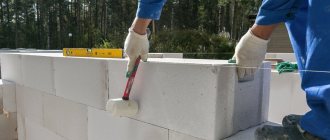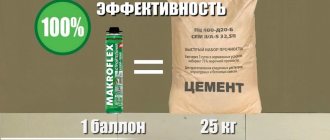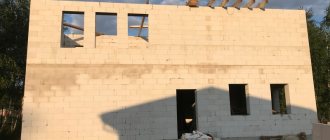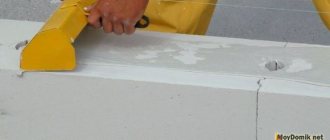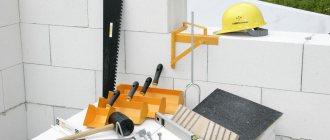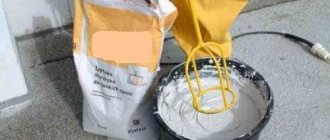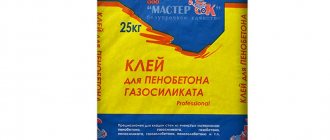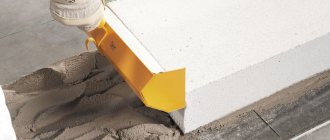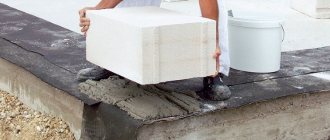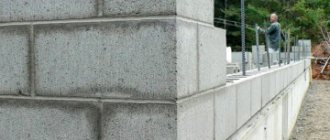The adhesive mixture is presented on the market in a large assortment of dry compositions, and is sold in packaged, marked paper packaging, marked “for gas blocks.”
How much glue you need to buy, and how to calculate it correctly for the construction of walls made of aerated concrete material, we suggest you find out from the presented article.
How much glue will you need?
The aerated concrete adhesive consumption per 1 m3 is approximately 23-26 kg, depending on a number of factors, or 1.5-1.7 kg per 1 m2.
Glue costs will be affected by:
- glue quality;
- recommendations for use stated by the manufacturer;
- temperature conditions (base and solution must be at least +50 C);
- condition of the blocks: with defects or even;
- weather;
- using the necessary tools (carriage or trowel-bucket), which speeds up the laying process, minimizes glue consumption and reduces the cost of work;
- number of reinforced layers;
- qualifications of workers: masons, as a rule, make 0.5 cm seams and few people use the 0.3 cm standard.
Choosing an adhesive in winter
If you have to construct a building in winter, then for the work you need to choose an adhesive that is suitable for cold weather, as well as one that can withstand low temperatures. This product usually contains additives that protect the surface from frost. However, when applying it to the surface, the air temperature should not be lower than -10°C.
The main properties of winter adhesive for aerated concrete:
- Availability of antifreeze additives.
- Grey colour.
- This material is used for any type of construction work.
- Lack of sensitivity to external factors.
- Frost resistance.
- Does not absorb moisture.
- In environmental terms, an absolutely clean product.
Frost-resistant glue must be stored in a warm room. Make the solution by adding warm water. Its temperature should not be lower than +10°C. The surface on which the glue will be applied must be absolutely clean. The time to use this product is half an hour.
Consumption of aerated concrete adhesive per 1 m3 in kilograms
| With a block thickness (cm) and a density of 300-400 kg\m3 | Consumption in kg\per cubic meter | Consumption kg\m2 |
| 10 | 19,3-19,4 | 1,9-2,0 |
| 15 | 19,9-21,0 | 2,9-3,0 |
| 20 | 16,4-16,8 | 3,3-3,5 |
| 25 | 15,9-16,2 | 4,0-4,4 |
| 30 | 15,5-15,8 | 4,6-5,2 |
| 37,5 | 15,1-15,4 | 5,7-6,0 |
| 40 | 14,9-15,1 | 6,0-6,3 |
How to check which glue is best for claque? It is necessary to purchase a kilogram of various compositions, prepare them according to the recipe and allow them to completely harden on the glued gas blocks (two are enough). After a day, you need to try to break the seam and assess the location of the break:
- the fracture coincides with the seam - glue should not be used;
- the fault partially touches the seam - the quality is in doubt;
- the seam remained undamaged and the gas block itself was damaged - excellent quality, this glue can be chosen for any work.
Another way to check is the weight of the glue after hardening. You need to fill the same amount of glue into several containers of the same size. A day later, weigh. Preference should be given to the solution whose weight is less. This indicates that a significant part of the moisture has gone and the mixture will be strong and no less thermally conductive.
Of course, testing glue is a troublesome and expensive task, but if large-scale construction is planned, you should not refuse to diagnose the declared parameters.
Advantages of aerated concrete adhesive:
- material consumption is 6 times lower, and the cost, unlike cement-concrete mortar, is only 1.5-2 times higher, so the savings are obvious;
- the use of a fine-grained mixture helps to avoid the formation of “cold bridges”;
- a thin layer of adhesive base can effectively emphasize the evenness of gas blocks;
- the solution can be used at any time as putty;
- the glue hardens without shrinking;
- the composition of the solution always remains homogeneous with regular stirring, which increases the adhesive strength;
- the plasticity of the material practically eliminates heat loss;
- thin-layer masonry of aerated blocks is much stronger and more durable than standard cement-sand mortars.
Adhesive compositions for aerated concrete
The tendency to absorb moisture has necessitated the use of a special adhesive for aerated concrete blocks, capable of retaining a sufficient amount of water for crystallization of the composition. A standard sand-cement mortar is not suitable here, since the water from it quickly goes into the body of the block, and the crystallization regime of the material is disrupted. It is impossible to obtain the required level of structural strength from such a connection.
It should be noted that some experts use a regular solution, generously wetting the surfaces of the blocks to reduce water loss. This gives its results, but cold bridges will definitely appear. This technique is used forcedly if the gas blocks are of poor quality, with uneven and too different edge sizes. Regular grinding cannot level them out, and you have to increase the thickness of the seam.
Workers of informal teams often lay aerated blocks on a regular mortar in order to speed up the laying process. They are driven by the usual reluctance to grind each row - this is a labor-intensive and very dusty procedure. If you had to hire such specialists, the customer must carefully monitor the progress of the work and promptly stop attempts to make the masonry easier at the expense of the quality and durability of the walls.
Dry adhesive mixtures for aerated concrete
According to technological requirements, specialized adhesive mixtures are used for laying gas blocks. They are created on the basis of conventional sand-cement mortar, but have moisture-retaining additives to conserve water and ensure normal hardening conditions. In addition, fine sand is used, which enhances the adhesion of the glue to the gas blocks. There is evidence on the Internet about tests carried out, when an aerated block laid on glue was tried to be beaten off with a sledgehammer. As a result, the block broke off from the masonry, but the adhesive seam remained in place and was not damaged.
There are many specialized formulations on the market. When choosing glue, you should pay attention to the mark “for cellular concrete”, or a more direct indication of aerated concrete or gas silicate blocks. However, sometimes the store does not have specialized compounds, and you have to urgently decide how to glue the aerated blocks so as not to stop construction. Many craftsmen have tried gluing gas blocks using tile adhesive. The results turned out to be quite satisfactory.
There are claims online that the adhesive for tiles and for gas silicate blocks is essentially the same composition. Tile adhesive for aerated concrete is a completely related material that provides good adhesion to aerated concrete and is practically no different from specialized mixtures. However, to obtain optimal results, it is recommended to choose compositions for outdoor use that can withstand winter frosts and temperature changes without loss of performance.
Adhesive foam
In addition, there are methods for installing aerated concrete blocks using foam adhesive. This is a polyurethane composition that looks very similar to polyurethane foam. It has several advantages:
- does not need to be sealed before laying, as it is sold ready-made;
- economical consumption (1 cylinder is required for 1 pallet of blocks);
- simplicity and high speed of application (three longitudinal strips of glue are made - at a distance of 3-5 cm from the edges and in the middle);
- The adhesive foam sets in 10 minutes, which is quite enough to install and level the next block.
Complete curing of the foam occurs 12 hours after application. However, gas silicate blocks can be processed or sanded without fear of accidentally moving them out of place within 40 minutes after installation. Application of glue is possible at temperatures from -10° to +35°, which allows construction work to be carried out both in summer and winter.
The official ranking of adhesive for gas silicate blocks is headed by Polish Tytan, which is sold in 0.75 liter cylinders. Each of them is capable of producing a continuous strip of glue 60 m long. However, Ytong foam glue, produced in the same cylinders, produces a continuous strip 110 m long, which is almost twice as long as its Polish counterpart. If we take into account the too high setting speed of Tytan glue (60 seconds), we can conclude that Ytong foam has a clear advantage. If you need to build a partition in a private house or apartment that is in use, it is not advisable to use cement glue or mortar. In such situations, polyurethane foam for gas blocks becomes the best option, providing a quick and durable connection of the partition elements.
In addition, aerated concrete can be laid on foam without moisture, and the possibility of voids forming in the joints is guaranteed to be eliminated. This is the most dangerous drawback of “wet” adhesive compositions - if the laying is carried out by untrained or inexperienced people, the so-called “waste space” may appear when through gaps appear in the walls between the gas blocks. Most often they occur at vertical joints, but sometimes horizontal voids also occur. When laying blocks on foam, such situations are completely eliminated, the connection is continuous and airtight.
Another benefit of foam that users need to be aware of is its low thermal conductivity. Polyurethane foam is an effective heat insulator, and the connections of aerated blocks automatically cease to be a risk factor for the occurrence of cold bridges.
Some users, in the absence of specialized compounds, use conventional polyurethane foam. However, despite the external similarity, these are different materials intended to solve completely different problems. If you place the gas block on special foam, you will get a strong and airtight connection. Mounting compositions are characterized by lower strength and insufficient adhesion to aerated concrete. They can only be used for additional sealing of seams, filling voids or defects in masonry with glue.
Combined masonry method
Despite the clear advantage of polyurethane foam for laying aerated concrete blocks, many builders treat it with caution. This is quite justified, since such methods of connecting blocks in the climatic conditions of our country have not yet been sufficiently studied. The elasticity of the seams has a lot of advantages, but the overall strength of the walls is somewhat reduced because of it. There is a discrepancy with the standard indicators of the mechanical properties of the masonry, which can cause deformations or destruction when multidirectional forces occur. For example, frost heaving of the soil or spring flooding of the foundation can cause changes in the configuration of the support system. It is still unknown how the elastic connection will behave under such conditions; the collected statistics are not enough.
At the same time, many builders are trying to use the positive properties of foam glue. They use combined installation methods, when a “wet” adhesive composition is applied to the horizontal surfaces of the rows, and the vertical seams are connected with foam. This method eliminates voids in side joints, which are considered the most risky in this regard.
The combined use of two compositions has its disadvantages - you have to purchase both types of glue, on the site you need to dilute the “wet” composition and calculate its quantity to the volume of aerated concrete that can be laid at one time (usually one row). However, the skills to work in this way appear very quickly, and the results give complete confidence in the strength and tightness of the walls.
How to prepare and use glue
To prepare the glue, you will need a construction mixer or drill with a suitable attachment. Dry concentrate is added to pre-drawn water (temperature up to +600 C). After thorough mixing, the solution is allowed to stand for 15 minutes and whisked again for about a minute. If the masonry will be carried out during the cold season, it is better to give preference to special adhesives with anti-frost additives and store the mixtures at a temperature not lower than +50 C. In hot weather, the solution is suitable for work up to 120 minutes, in cold weather - 25-30 minutes.
When using an adhesive composition, it must be taken into account that the solution requires stirring every 15-20 minutes to maintain the homogeneity of its consistency.
It is undesirable to carry out work in strong winds or precipitation (rain, snow). This way the solution will “gain moisture”, which will affect its adhesive ability.
Before using the adhesive base directly, it is worth carrying out a test bonding to determine what thickness of the seam will be optimal.
Approximately, the indicators will be as follows: for 1 kg of ordinary glue 0.3 liters of water; for the winter mixture you will need 0.2 liters. At the same time, the time spent on laying and correcting blocks is reduced to the required minimum.
Glue consumption for aerated concrete per 1 m3
When building a new home, people are increasingly choosing a material such as aerated concrete. It is often placed on dry adhesive mixtures, rather than on a regular solution. Because the glue has lower thermal conductivity, thereby allowing for better heat retention inside the house. To calculate the required amount of adhesive material for construction, you need to know the aerated concrete adhesive consumption per 1 m³.
Mode of application
Required Tools
To prepare the solution you will need:
- a container in which you will need to stir the dry bulk mixture with water;
- a drill with a special attachment (to obtain the correct consistency of sour cream, use a construction mixer);
- measuring device to maintain correct proportions.
To apply glue and carry out masonry, use a steel or notched trowel or a trowel-bucket (carriage) for aerated concrete.
Return to contents
Cooking method
Dry mixtures are sold in 25 kg bags. To prepare the adhesive composition, the calculation is as follows: one factory package requires five to five and a half liters of clean water (that is, 200-220 milligrams are taken per 1 kg). The liquid should be warm (from 15-18 to 60 °C).
After kneading, you should get a mass without lumps. It needs to be allowed to “settle” for five to ten minutes, and then stirred again. The glue is usable for only a couple of hours, so it is prepared in portions.
Return to contents
Application method
Apply aerated concrete adhesive in a minimal layer to clean blocks (without dust, dirt, or oil stains). The thickness of the joints during laying should not exceed 2-4 millimeters. The excess is removed immediately or cut off with a trowel after hardening. The position of the blocks can be adjusted within about ten minutes (perhaps with a rubber hammer). Level the surface by lightly tapping
Note. It is necessary to protect yourself from getting the prepared solution into your eyes and skin, so it is recommended to use protective clothing and gloves. A respirator or gauze bandage will not interfere.
Return to contents
general information
The structure of aerated concrete material is very porous. For this reason, the mortar on which the blocks will be laid must have high astringent properties. Special ready-made mixtures fully satisfy this requirement.
The main materials from which aerated block adhesive is made:
- cement grade 500 and higher;
- fine sand;
- various additives (for moisture resistance, increasing strength, viscosity, etc.).
Compared to cement-sand mortar, the price of ready-made mixtures is much higher. But thanks to the low cost of adhesive bases, the cost is almost equal, and the quality of the masonry increases.
Advantages of ready-made mixtures:
- high plasticity;
- water-repellent properties;
- do not collapse from severe frosts;
- hardens very quickly (no need to wait before laying the next row).
Using glue you can achieve high adhesion of aerated concrete blocks. And also the seams will not crack at high humidity levels.
The types of glue used in construction vary depending on the season. If work takes place in winter, then frost-resistant mixtures must be used. They contain special plasticizers that allow aerated concrete to be laid at low temperatures. This glue is prepared in warm water (not lower than 35 degrees). It should be taken outside immediately before application. You need to consume the finished material as quickly as possible. This should take no more than five minutes.
You can significantly reduce the consumption of glue for gas silicate blocks by 1 m³ if you use a special tool. This will also help reduce laying time. Required tool:
- cement bucket;
- rubber mallet;
- high carbon steel hacksaw;
- mixer (required);
- corner 90 degrees;
- grater or sandpaper;
- metal grater.
The aerated concrete block (sibit) must be dry. Before applying the glue, it should not be wetted, as when using cement-sand mortar. The block also needs to be cleaned of dirt, if any.
TOP 10 best brands of glue for gas silicate blocks
To choose a good option and not make a mistake, you need to focus on the rating of glue for gas silicate blocks, which we have prepared especially for you. There are many current offers on the market, and below is a list of the most popular brands of dry concentrate.
Zabudova
A universal mixture, often used for use in winter. It contains a special substance that prevents freezing even at very low temperatures. According to reviews from builders, this glue is easy to apply. In addition, the product has a fairly low competitive price, thanks to which it is very popular in the market. Most consumers believe that this is the best adhesive for gas silicate blocks!
Prestige
This domestically produced composition is also resistant to frost. Suitable for laying cellular blocks and whole slabs. The advantage of this option is the speed of preparation. However, the price of Prestige is slightly higher than that of Zabudov.
Bonolit
Another winter option for concentrate. It is valued for its environmental friendliness - the adhesive for gas silicate blocks "Bonolit" does not contain toxic substances. It is absolutely harmless to health. Accordingly, the cost of such glue is higher than that of competitors in this segment.
Eunice Uniblock
This glue has gained great demand due to its inherent advantages:
- excellent thermal insulation characteristics;
- increased moisture resistance;
- resistance to temperature and pressure changes;
- environmental friendliness, absence of harmful impurities;
- durability and high strength of masonry;
- The optimum ratio of price and quality.
AEROC
A distinctive feature of Aeroc adhesive concentrate is its increased installation strength. Also suitable for cellular blocks. The application technology requires low consumption - a very thin layer of this polyurethane adhesive (from 1 to 3 mm) will provide good adhesion for the walls.
Among the advantages of Aeroc are also its vapor tightness, moisture and frost resistance.
The finished composition is suitable for use within two hours, unlike glue from competing companies. But its cost is much higher.
Will win
A multicomponent mixture, this adhesive for gas silicate blocks contains cement, quartz sand and modifiers. The distinctive properties of Pobedit are its manufacturability and plasticity - it does not form a sticky layer on tools, hardens quickly and is not susceptible to moisture. The price of such mounting adhesive is low.
Aerostone
Concentrate with a cement base and polymer substances in the composition. The manufacturer (Dmitrovsky plant) produces glue in two versions of Portland cement - gray and white.
Ilmax 2200
This option is used for laying porous blocks - gas silicate, foam concrete, expanded clay. Has increased resistance to frost. This mixture can be used in the temperature range from +5 to +25°C, and the performance characteristics allow the mixture to remain unchanged at temperatures from +70 to -30°C. The prepared composition can be used within 4 hours.
CERESIT ST21
The most famous construction brand. Ceresit supplies high quality mixtures for a wide range of construction work. The composition of the adhesive is cement with the addition of organic modifying substances and mineral fillers. It involves application in a fairly thin layer, which makes this mixture option economical.
KNAUF LM 21
Another well-known manufacturer of building materials and dry concentrates. The composition for gas silicate blocks from the Knauf brand has a gypsum base that provides a strong, hermetically sealed connection. Also, Knauf mixtures are environmentally friendly, easy to prepare and apply. And the world famous brand and impeccable quality make the price of this product high.
In the construction of modern buildings, block technology is increasingly used. To achieve optimal adhesion of gas silicate, it is necessary to choose an adhesive that meets all quality requirements and not make mistakes in calculating the quantity. By observing all the parameters necessary for working with the concentrate, as well as the manufacturer’s instructions, the finished masonry will be durable and strong under any operating conditions. And remember that the cost of glue for gas silicate blocks is not responsible for its quality!
Dependence of material consumption
The packages usually indicate how much glue is used for 1 cubic meter of aerated concrete. When construction involves large volumes of work, the amount of material spent can significantly exceed the standards stated by the manufacturer. The difference can be very impressive in the consumption of aerated concrete adhesive per 1 m3. But there are also opposite situations. When calculating the required amount of mixture, several factors must be taken into account:
- Properties of the adhesive composition. The more fractional impurities in the mixture, the higher the need for a large layer. If the composition is based on adhesives and binding substances, then you can get by with a minimal layer (2-3 mm).
- Layer qualification. Proper technique for using bonding material greatly influences the flow rate. Beginners often spend too much solution when laying aerated concrete blocks.
- The presence of a layer of reinforcement. If a reinforcing layer is provided in a gas-block wall, then the consumption of the mixture will greatly increase.
- Rejection of gas blocks. If you use a solution with a large amount of binding substances and the correct installation technique, and the gas block has defects, then the consumption can increase significantly.
Taking these criteria into account, you can roughly calculate how much glue consumption for aerated concrete blocks should be included in the estimate. This will also help you avoid unnecessary expenses.
Masonry adhesive Kreps
All mixtures, at least slightly, differ from each other in their composition. This largely determines the cost of material during the construction of a house. “Kreps” is one of the most economical mixtures for laying aerated blocks. It contains fine sand, high-quality cement and various plasticizers that help better bind aerated concrete blocks.
If all standards are observed, the average thickness of the adhesive layer is 2 mm. If you use a minimum thickness of joints, you can minimize the risk of cracks. One bag of dry mixture is consumed per cubic meter of aerated concrete blocks.
You can calculate expenses not by volume, but by area. In this case, the consumption will be 1.5−1.6 kg per 1 m². Any physical impact is not terrible even with a thin layer of seams. Low temperatures and mechanical loads do not affect the final result.
Insi-Block mixture consumption
This manufacturer produces not only ready-made mixtures for masonry, but also directly aerated concrete blocks. When making glue, mineral additives are also added to the standard set of materials. This allows you to increase the threshold of strength and adhesion. But high quality properties can only be achieved if the required layer specified by the manufacturer is applied (thickness from 2 to 4 mm). Dry material consumption is 28 kg per cubic meter of aerated concrete blocks.
Such expenses were calculated based on a layer of 2 mm. If the thickness of the seam is increased, then the consumption, accordingly, will also be increased. This mixture comes to the market in 25 kg bags, so, for example, for 10 cubic meters of blocks you need to buy 11-12 bags of dry glue. One bag requires 5-5.5 liters of water. If you follow this proportion, the finished solution can be used within three hours .
Masonry mixture Real
This adhesive for masonry aerated concrete mixtures is quite famous among builders. Made from cement. Frost resistance and water resistance are at an average level. If work takes place in the cold season, then you cannot do without frost-resistant additives. The main advantage is the ability to place blocks on a very thin layer of glue, which allows you to save a lot on material. This is achieved thanks to a high level of plasticity and water-repellent ability (adhesion).
"Real" allows you to lay the aerated block on a layer of 1 mm. With such a seam, the consumption per cubic meter of block is 21 kg of dry mixture. This glue is one of the most economical on the market at the moment. The quality of the masonry does not deteriorate due to this. This also allows you to save on plaster when facing walls. The average layer thickness decreases from 8 mm to 5 mm.
Popular adhesive mixtures
When deciding which adhesive to choose for gas silicate blocks, it is worth studying the features of current offers.
- Aerostone is a product of the Dmitrovsky Aerated Concrete Products Plant. Cement-based mixture with polymer additives. The product is presented in winter and summer versions.
Aerostone adhesive for gas silicate blocks
- Thermocube is an adhesive mixture for interior and exterior work, intended for thin-seam masonry of walls and partitions based on grooved and grooveless gas silicate blocks. The building material is distinguished by high qualities of strength, frost resistance and ductility. Provides economical consumption.
- Ilmax2200 – adhesive for laying blocks of porous concrete, including gas silicate, foam concrete, expanded clay concrete slabs and other wall panels. Frost resistance of the product is 75 cycles, operating temperatures range from -30°C to +70°C, temperatures for block laying work range from +5°C to +25°C. The prepared solution is used within 4 hours.
- Ceresit is perhaps one of the most popular construction brands, a supplier of high-quality mixtures for various categories of work. Ceresit CT21 adhesive is made on the basis of cement; mineral fillers and organic modifiers are included as additives. The product is used for thin-layer masonry of gas silicate wall blocks and other types of cellular concrete panels.
- Knauf - a gypsum-based adhesive composition provides strong adhesion to the surface. The products of this manufacturer are in demand due to their competitive quality, although they are sold in the expensive segment. Knauf Perlfix adhesive mixtures with an environmentally friendly composition are easy to apply and allow you to quickly level the blocks.
- IVSILBlock - the mixture is used for laying grooved and conventional blocks made of porous concrete. Polymer inclusions increase adhesion, and modifying additives impart plasticity to the binder base. The position of the blocks when laying with this solution can be adjusted within 25 minutes, which is considered a competitive advantage of the material.
- Aeroc is a product of a company producing cellular concrete from St. Petersburg and occupies a leading position in the domestic market of construction resources.
- "Zabudova" is one of the best adhesives for gas silicate blocks. The products are valued for their high performance when used in winter at a relatively low cost. The composition performs well at ambient temperatures down to -15°C, is easy to mix and apply, consumption is more than economical, seams are not subject to atmospheric influences.
- Unic Uniblock is a brand that produces high-quality gas silicate blocks and masonry mixtures; the products are sold in the middle segment.
- Bonolit - a dry concentrate for gluing gas silicate deserves attention due to its absolutely environmentally friendly composition, has no toxic impurities, and is in demand for both external and internal work.
Adhesive for gas silicate blocks Bonolit
- “Prestige” - the mixture is used for laying all types of porous concrete blocks; it is characterized by high frost resistance due to its composition with modifiers.
- “Pobedit” is a multicomponent cement-based adhesive with quartz sand and polymers; its composition is completely identical to aerated concrete blocks and is capable of adhering to the surface with the highest quality, forming a monolithic composition.
- "EK Chemical" - the mixture is intended for thick-layer masonry, suitable for work in any season. In addition to constructing walls and partitions from blocks based on cellular concrete, the composition can be used when installing ceramic tiles and leveling wall surfaces.
Optimal adhesive consumption for aerated concrete
It is impossible to calculate the average consumption of mixtures, since it is different in each individual situation. At such moments, builders are faced with a completely different question: will the increased waste of glue be justified, or is it better to go the other way and reduce consumption to a minimum, which will reduce cold bridges?
Manufacturers are trying to make glue that allows thin seams to be made. This is due to the fact that a thick layer does not make the masonry stronger, but the thermal insulation of the house deteriorates (aerated concrete retains heat much better than hardened glue). Thin seams allow for maximum heat retention and are also easier to make straight joints.
The approximate average consumption of adhesive for masonry aerated concrete can be taken as 30 kg of dry mixture. If there are too large deviations from this value, this may mean that the wrong masonry technology has been chosen or the gas blocks have serious deviations.
How to calculate glue consumption for aerated concrete blocks
Houses made from aerated concrete blocks are distinguished by increased heat and sound insulation characteristics, combined with an affordable price. Their disadvantage is increased hygroscopicity. It can be reduced if the blocks are laid on special compounds, calculating the adhesive consumption for aerated concrete.
Seasonal varieties
Universal gray glue is used not only in winter, but also in summer.
Nowadays two types of mixtures are used for the construction of buildings. Adhesive for aerated concrete blocks is:
- White. It is considered summer, used in warm seasons. It owes its light shade (the same as that of autoclaved aerated concrete) to white Portland cement, which makes it possible to save on interior decoration.
- Gray. Although this type is called winter, it is universal and suitable for work in any season. Due to the presence of antifreeze additives in the composition, it is recommended for use in cold weather, however, it also has a certain temperature limit.
Return to contents
Description and characteristics of the material
The blocks can be laid on traditional cement mixtures or special dry compositions from which the mortar is prepared. But preference should be given to the latter. Despite the fact that glue is twice as expensive as cement, it is more economical. But this is not the only advantage.
It consists of the following components:
Such compositions are used when laying blocks of aerated concrete, foam concrete and other materials with a high level of moisture absorption. They have high adhesion, moisture and frost resistance and plasticity. The glue sets quickly without shrinkage, eliminating the risk of the formation of “cold bridges” characteristic of cement mortars. But to achieve this effect, you need to make the correct calculation of the aerated concrete adhesive.
Another positive quality is its simplicity and ease of use. To prepare the solution, you need to mix the dry composition with water in the proportions indicated on the package. For mixing, use a drill with a mixer attachment or a construction mixer.
Famous manufacturers
As an example, the pros usually recommend several already proven brands of adhesives for aerated concrete. Among them:
- AEROC. For external and internal work, in winter/summer options;
- Ceresit CT21. For internal and external types of masonry, puttying of internal surfaces;
- Moment. Has high adhesion to the base;
- Kreisel 125. In addition to gas and foam concrete, it is suitable for laying polystyrene concrete blocks and foam concrete;
- Bonolit (Bonolit). Relatively new brand. It is interesting due to the presence of antifreeze modifying additives in its composition;
- Volma – Frost-resistant block. Installation is possible at temperatures down to -15 °C.
Experts recommend not skimping on the quality of adhesives, choosing trusted manufacturers, those brands about which there are consumer reviews. If dry products are purchased for future use, they should be stored in unopened packaging. The room used for storage must be dry and heated. If these conditions are met, the shelf life is one year from the date of production of the material.
Rules for calculating material consumption
Glue is applied to the surface of aerated concrete. The seam size should be 1–3 mm. Standard calculations assume a material thickness of 1 mm. Traditionally, 1 m 2 of aerated concrete blocks requires from 1.5 to 1.6 kg of dry mixture. But this calculation is applicable only when using blocks with a perfectly flat surface.
Now you need to calculate how much glue is needed for one cube of aerated concrete. On average, 25 kg (1 bag) of dry mixture is consumed per 1 m3. But, as mentioned above, this number is very relative.
As practice shows, 37.5 kg of glue or 1.5 bags are spent per 1 m 3. And this is not a matter of deception by the manufacturer. Material consumption depends on several factors:
- builder qualifications;
- condition of aerated concrete blocks (presence of defects, etc.);
- number of layers;
- air temperature.
Companies that produce glue place instructions for use on the packaging. Therefore, before starting work, you need to carefully study it and prepare the mixture, following the manufacturer’s recommendations.
saving glue
Manufacturers of adhesive solutions give different recommendations regarding what the glue consumption should be.
They concern not only dilution, but also the laying of the composition, as well as the formation of block masonry with its help:
- First of all, read the instructions from the manufacturer before starting to dilute the adhesive solution from the dry mass.
- Follow the technology for preparing the composition, then the material consumption will be less, and accordingly, the cost of the glue will be reduced.
- When laying blocks, observe the temperature conditions required by the manufacturer.
- To maintain the homogeneity of the composition, stir it periodically while laying the blocks.
- If you are laying blocks with glue yourself and do not have the necessary experience from a specialist, it is better to purchase all the materials with a reserve.
- By applying glue to the surface of the block with a notched trowel, you can reduce the consumption of the mixture by an average of 25-30%.
- It is better to prepare glue from dry mass in a warm room, and then deliver it to the site where the block walls are being erected.
We invite you to watch a video about fast and high-quality laying of blocks:
The correct choice and use of glue for blocks allows you to build a high-quality and durable home with good thermal insulation properties.
How to reduce material consumption
When laying aerated concrete blocks using special glue, it is necessary to follow the technology. This way you will be able to maintain the required consumption rate for the dry adhesive composition and prevent its premature drying.
The temperature of the mixture should be at least +5°C. During the work, it must be stirred periodically, not allowing the components to split. If you plan to build a house in winter, you need to buy anti-frost additives along with the glue. Instead of additives, you can purchase a ready-made mixture that already includes them.
The time for applying the finished solution and installing the blocks should not exceed 15 minutes. If there is a need to adjust the masonry, it is done within 3 minutes. The prepared mixture should be completely consumed within 2 hours.
At negative air temperatures, the glue sets faster, so its use time is also reduced. The dry mixture is mixed with water, the temperature of which can vary from 40°C to 60°C. It is taken outside in a container covered with a lid.
In winter, it is not enough to know how much glue is needed per cube of aerated concrete. At this time of year, even experienced craftsmen carefully ensure that the seams are filled as completely as possible, without allowing their thickness to increase. Therefore, it is advisable for novice craftsmen to start building a house from aerated concrete in the warm season.
To minimize material consumption, the adhesive composition must be applied in a thin layer. As a result, it will be possible to perform even and durable masonry, achieving stable adhesion and rapid hardening.
Related video: Calculating the feasibility of using special adhesive for masonry aerated concrete
Review of popular brands of winter adhesive for aerated concrete
Features of installation of partitions made of aerated concrete blocks
A competent approach to the construction of houses from aerated concrete blocks
Standard indicators of adhesive consumption for aerated concrete
Before starting construction, there is a need to estimate the costs of building materials. When building walls, it is quite easy to estimate the cost of building blocks, but it is difficult to calculate the amount of mortar needed for masonry. In the case of aerated concrete, a special construction mixture is used, which can be purchased in bags weighing 25 kg.
Adhesive for aerated concrete
To estimate costs, you need to calculate the number of bags that need to be purchased. Typically, the consumption rate of aerated concrete adhesive is indicated on the packaging; it is 4 bags per pallet (in practice - 6). If we evaluate it in cubes, then on average up to 1.5 bags of adhesive mixture are needed per 1 m3.
Types of blocks used
The construction of a new architectural project invariably entails the selection of the necessary building materials. For a long period of time, brick remained the main element of construction, but now it is used less and less. The main reason for this is the complexity of laying bricks. In addition, the price of brick analogues is significantly lower.
Today, building blocks, presented in a wide variety on the construction market, have become a worthy replacement for bricks. Their main varieties are the following:
- Expanded clay concrete blocks. The material has a number of advantages. It successfully combines qualities such as high strength and low weight. The use of blocks involves a small investment of time to create durable masonry. Expanded clay concrete block elements allow the construction of buildings up to 3 floors high manually, without the use of special equipment.
- Concrete blocks. This material is rarely used in the construction of residential buildings, since it is characterized by poor thermal insulation properties. However, their frost resistance and strength allow builders to use the material for the construction of buildings of economic importance.
- Gas silicate blocks. In the construction environment they are also known as cellular concrete. The profitability of their use is due to significant cost savings. The small dimensions of the gas silicate block save useful space.
- Polystyrene concrete blocks. When creating them, a special substance is added to a regular concrete solution, which helps make the material frost-resistant, has good soundproofing properties, and durable. The low price of polystyrene concrete blocks makes the final cost of construction low. Polystyrene concrete blocks are used in both private and industrial construction.
- Foam concrete blocks. When carrying out construction using foam concrete blocks, there is no need to use special equipment if the height of the building does not exceed 3 floors. Foam concrete blocks are used in the construction of cottages. Their main advantages include environmental safety.
How to calculate the volume of adhesive for aerated concrete?
The calculation of the masonry mixture is based on the number of blocks. The total volume is estimated according to the following parameters. In practice, you need to find out for calculations how thick the wall of your building should be. It depends on the type and heat load factor of the room. Usually determined according to GOST depending on the climate zone. If the useful thickness of a wall made of aerated concrete is not enough, some owners increase the volume of the blocks. Others decide to insulate the walls additionally (thereby shifting the dew point outside the wall). This allows you to bring thermal conductivity to normal.
Usually the consumption of aerated concrete adhesive per 1 m3 is indicated; you can also recalculate how much is required per 1 m2 when calculating the volume of the wall. For these purposes, you can use a special calculator that allows you to calculate the required volume by entering several wall parameters.
Let's give a general example of calculation for 1 m3, how to do this in practice:
- select the block thickness;
- estimate the total length (perimeter) and height of the walls;
- multiply the perimeter, the height of the wall by the thickness of the block;
- From the resulting volume, you can calculate the required amount of mixture according to the manufacturer’s recommendations.
This useful volume allows you to estimate the costs of all necessary building materials. Including the consumption of the adhesive mixture.
Types of aerated concrete wall masonry
Why can more glue be used per 1 m3 when laying a box in a house made of aerated concrete?
When you receive a pallet from the manufacturer, you can read the recommended consumption, the so-called norm, on the label affixed to the pallet. It is usually 4 bags per pallet.
Exceeding the recommended volume is affected by:
- incorrect block geometry, which is leveled using mortar;
- additional sealing of seams;
- when constructing partitions due to the larger volume of blocks;
- installation skills.
The influence of these factors leads to an increase in the volume of the solution by an average of 1.5 times. A pallet usually requires 3.5 bags; we repeat, a cube of blocks requires 1.5 bags weighing 25 kg.
Why do you need to know how much mixture you will need?
It is necessary to calculate the adhesive composition in order to:
- Save money. Glue is 2 times more expensive than cement mortar, but its consumption is reduced by 5-6 times.
- Constant continuous construction process. It is important to eliminate the lack of construction of adhesive material, so as not to be distracted by additional time for its acquisition and delivery.
- The calculation always helps to check the estimate. This circumstance is especially important for large volumes of construction, when a team of construction workers from the company is working on site.
- Correct calculation of the volume of solution eliminates errors.
Many experts advise adhering to an important rule used when constructing aerated concrete walls - always add 1 bag to the calculation result obtained . Such a precautionary reserve will never be superfluous.
For example, for twenty cubes of blocks with a thickness of 1 mm, you need 21 bags of glue + one more, which means we get 22 bags.
Attention! When laying the adhesive composition, there is no need to overuse it due to the formation of large joints in width (more than 4 mm), since the masonry will very quickly lose its characteristics in terms of strength, tightness and thermal insulation properties - cold bridges will be formed between the gas blocks.
Standards based on 1 m2
There are calculation standards based on the thickness of the block, based on 1 m2. To obtain the required volume, you only need to know the area of the wall. It is calculated by multiplying the perimeter of the walls by the height.
| Aerated concrete block | Consumption per 1 m2 |
| Single layer walls (partitions), 600*400*250 | 10 kg |
| In two layers, 600*300*250 | 7.5 kg |
| Three layers, 600*300*250 | 7.5 kg |
Savings when constructing multilayer walls on a cube are obtained due to the peculiarities of the technology and the smaller free surface covered with the solution.
What you need to know about aerated concrete adhesive
Glue for aerated concrete blocks is a regular cement-sand mixture, which has its own characteristics. First of all, it is fine grinding and special proportions of an adhesive mixture that improves adhesion, cement and sand. Ideally, the layer between bricks should be 1-2 mm. This can be done if you follow the technology and skills in applying the solution. In practice, not every builder can lay blocks this way, so the recommended consumption increases. Which one depends on the specific case, but overspending can be averaged.
Keep in mind that the recommended layer of 1-2 mm ensures minimal heat loss, so you should adhere to the rules of masonry and achieve the thinnest seam. If this causes difficulties in advance, special microspheres filled with gas can be added to the glue. They also have a small fraction, and at the same time they allow you to insulate the mixture used, eliminating cold bridges.
This way out of the situation is suitable for builders without experience who are engaged in the construction of a building for personal purposes. Additives in the form of microspheres help to avoid possible heat leaks through the joints between bricks. If you do not have this material - how to get out of the situation, purchase bulk vermiculite. With its help, you can also insulate the masonry mortar and make larger seams without compromising the thermal conductivity of the structure.
Please note that the consumption of aerated concrete adhesive per m2 in the online calculator is given taking into account the standard consumption. When building independently without skills, it is better to estimate how much actual volume will be spent on your event; for this, use a factor of 1.3-1.5.
Regular glue in sub-zero temperatures
An adhesive mixture, the composition of which does not include the necessary anti-freeze components, cannot be used for construction work when the thermometer is below zero!
Conventional glue will practically not harden, and will not gain even the minimum strength sufficient to fix aerated concrete blocks. Further operation of such a building will be short-lived and even dangerous for human life.
